Novel Magnetite (Fe3O4)-Methylcellulose Nanocomposites Synthesized Using the Reverse Co-Precipitation Approach
Abstract
:1. Introduction
2. Materials
2.1. Synthetization of Magnetite Nanoparticles
2.2. Fabrication of MC/Magnetite Nanocomposites
2.3. Characterizations
3. Results and Discussion
3.1. Structure and Morphologic Characterization of Magnetite Nanoparticles (Fe3O4 NPs)
3.2. Optical Characterization
3.3. Magnetization Analysis
4. Conclusions
Author Contributions
Funding
Data Availability Statement
Acknowledgments
Conflicts of Interest
References
- Mahmed, N.; Heczko, O.; Söderberg, O.; Hannula, S.P. Room Temperature Synthesis of Magnetite (Fe3−δO4) Nanoparticles by a Simple Reverse Co-Precipitation Method. IOP Conf. Ser. Mater. Sci. Eng. 2011, 18, 032020. [Google Scholar] [CrossRef]
- Liu, S.; Yu, B.; Wang, S.; Shen, Y.; Cong, H. Preparation, surface functionalization and application of Fe3O4 magnetic nanoparticles. Adv. Colloid Interface Sci. 2020, 281, 102165. [Google Scholar] [CrossRef]
- Mohammadi, H.; Nekobahr, E.; Akhtari, J.; Saeedi, M.; Akbari, J.; Fathi, F. Synthesis and characterization of magnetite nanoparticles by co-precipitation method coated with biocompatible compounds and evaluation of in-vitro cytotoxicity. Toxicol. Rep. 2021, 8, 331–336. [Google Scholar] [CrossRef]
- Rahmayanti, M. Synthesis of Magnetite Nanoparticles Using The Reverse Co-precipitation Method With NH4OH as Precipitating Agent and Its Stability Test at Various pH. Nat. Sci. J. Sci. Technol. 2020, 09, 54–58. [Google Scholar] [CrossRef]
- Dudchenko, N.; Pawar, S.; Perelshtein, I.; Fixler, D. Magnetite Nanoparticles: Synthesis and Applications in Optics and Nanophotonics. Materials 2022, 15, 2601. [Google Scholar] [CrossRef]
- Kalubowilage, M.; Janik, K.; Bossmann, S.H. Magnetic Nanomaterials for Magnetically-Aided Drug Delivery and Hyperthermia. Appl. Sci. 2019, 9, 2927. [Google Scholar] [CrossRef]
- Fatima, H.; Charinpanitkul, T.; Kim, K.-S. Fundamentals to Apply Magnetic Nanoparticles for Hyperthermia Therapy. Nanomaterials 2021, 11, 1203. [Google Scholar] [CrossRef]
- Fernández-Barahona, I.; Muñoz-Hernando, M.; Ruiz-Cabello, J.; Herranz, F.; Pellico, J. Iron Oxide Nanoparticles: An Alternative for Positive Contrast in Magnetic Resonance Imaging. Inorganics 2020, 8, 28. [Google Scholar] [CrossRef]
- Challagulla, S.; Nagarjuna, R.; Ganesan, R.; Roy, S. Acrylate-based Polymerizable Sol-Gel Synthesis of Magnetically Recoverable TiO2 Supported Fe3O4 for Cr(VI) Photoreduction in Aerobic Atmosphere. ACS Sustain. Chem. Eng. 2016, 4, 974–982. [Google Scholar] [CrossRef]
- Wei, Y.; Han, B.; Hu, X.; Lin, Y.; Wang, X.; Deng, X. Synthesis of Fe3O4 Nanoparticles and their Magnetic Properties. Procedia Eng. 2012, 27, 632–637. [Google Scholar] [CrossRef]
- Petcharoen, K.; Sirivat, A. Synthesis and characterization of magnetite nanoparticles via the chemical co-precipitation method. Mater. Sci. Eng. B 2012, 177, 421–427. [Google Scholar] [CrossRef]
- Kazemzadeh, H.; Ataie, A.; Rashchi, F. Synthesis of Magnetite Nano-Particles by Reverse Co-Precipitation. Int. J. Mod. Phys. Conf. Ser. 2012, 05, 160–167. [Google Scholar] [CrossRef]
- Kupracz, P.; Coy, E.; Grochowska, K.; Karczewski, J.; Rysz, J.; Siuzdak, K. The pulsed laser ablation synthesis of colloidal iron oxide nanoparticles for the enhancement of TiO2 nanotubes photo-activity. Appl. Surf. Sci. 2020, 530, 147097. [Google Scholar] [CrossRef]
- Pouretedal, H.R.; Bashiri, Z.; Nasiri, M.; Arab, A. Photo-treatment of TNT wastewater in the presence of nanocomposite of WO3/Fe3O4. Part. Sci. Technol. 2021, 39, 971–980. [Google Scholar] [CrossRef]
- Hasanpour, M.; Motahari, S.; Jing, D.; Hatami, M. Statistical analysis and optimization of photodegradation efficiency of methyl orange from aqueous solution using cellulose/zinc oxide hybrid aerogel by response surface methodology (RSM). Arab. J. Chem. 2021, 14, 103401. [Google Scholar] [CrossRef]
- Shekhar, S.; Sajitha, E.; Subramanyam, S. High coercivity below percolation threshold in polymer nanocomposite. J. Appl. Phys. 2008, 104, 083910. [Google Scholar] [CrossRef]
- Nasatto, P.L.; Pignon, F.; Silveira, J.L.M.; Duarte, M.E.R.; Noseda, M.D.; Rinaudo, M. Methylcellulose, a Cellulose Derivative with Original Physical Properties and Extended Applications. Polymers 2015, 7, 777–803. [Google Scholar] [CrossRef]
- Mostafa, M.; Saleh, O.; El-Shahawy, M.; Ghazy, R.; Hemeda, O.; Abd El-Kareem, S.; Dorgham, A. Effect of Methyl Cellulose "MC" on some physical properties of Nickel Magnesium Ferrite—MC nanocomposite. Arab J. Nucl. Sci. Appl. 2022, 55, 16–28. [Google Scholar] [CrossRef]
- Kim, J.K.; Won, Y.-W.; Lim, K.S.; Kim, Y.-H. Low-Molecular-Weight Methylcellulose-Based Thermo-reversible Gel/Pluronic Micelle Combination System for Local and Sustained Docetaxel Delivery. Pharm. Res. 2012, 29, 525–534. [Google Scholar] [CrossRef]
- Bordbar-Khiabani, A.; Gasik, M. Smart Hydrogels for Advanced Drug Delivery Systems. Int. J. Mol. Sci. 2022, 23, 3665. [Google Scholar] [CrossRef]
- Adepu, S.; Ramakrishna, S. Controlled Drug Delivery Systems: Current Status and Future Directions. Molecules 2021, 26, 5905. [Google Scholar] [CrossRef] [PubMed]
- Nyquist, R.A.; Kagel, R.O. Handbook of Infrared and Raman Spectra of Inorganic Compounds and Organic Salts: Infrared Spectra of Inorganic Compounds; Academic Press: Cambridge, MA, USA, 2012; Volume 4. [Google Scholar]
- Anamika; Singh, V.; Yadav, B.K. Adsorption study of Heavy Metals from Aqueous Solutions using Magnetite Nanoparticles. J. Phys. Conf. Ser. 2020, 1504, 012011. [Google Scholar] [CrossRef]
- Mansour, S.A.; Farha, A.H.; Tahoun, B.A.; Elsad, R.A. Novel magnetic polyaniline nanocomposites based on as-synthesized and surface modified Co-doped ZnO diluted magnetic oxide (DMO) nanoparticles. Mater. Sci. Eng. B 2021, 265, 115032. [Google Scholar] [CrossRef]
- Tunç, S.; Duman, O. Preparation and characterization of biodegradable methyl cellulose/montmorillonite nanocomposite films. Appl. Clay Sci. 2010, 48, 414–424. [Google Scholar] [CrossRef]
- Aziz, S.B.; Rasheed, M.A.; Ahmed, H.M. Synthesis of Polymer Nanocomposites Based on [Methyl Cellulose](1−x):(CuS)x (0.02 M ≤ x ≤ 0.08 M) with Desired Optical Band Gaps. Polymers 2017, 9, 194. [Google Scholar] [CrossRef] [PubMed]
- Rao, Y.; Chen, S. Molecular Composites Comprising TiO2 and Their Optical Properties. Macromolecules 2008, 41, 4838–4844. [Google Scholar] [CrossRef]
- Mizukoshi, Y.; Shuto, T.; Masahashi, N.; Tanabe, S. Preparation of superparamagnetic magnetite nanoparticles by reverse precipitation method: Contribution of sonochemically generated oxidants. Ultrason. Sonochem. 2009, 16, 525–531. [Google Scholar] [CrossRef] [PubMed]
- Han, D.H.; Wang, J.P.; Luo, H.L. Crystallite size effect on saturation magnetization of fine ferrimagnetic particles. J. Magn. Magn. Mater. 1994, 136, 176–182. [Google Scholar] [CrossRef]
- Lin, C.-R.; Chu, Y.-M.; Wang, S.-C. Magnetic properties of magnetite nanoparticles prepared by mechanochemical reaction. Mater. Lett. 2006, 60, 447–450. [Google Scholar] [CrossRef]
- Kong, I.; Ahmad, S.; Abdullah, M.; Yusoff, A. The Effect of Temperature on Magnetic Behavior of Magnetite Nanoparticles and Its Nanocomposites. AIP Conf. Proc. 2009, 1136, 830–834. [Google Scholar]
- Jacobo, S.E.; Aphesteguy, J.C.; Lopez Anton, R.; Schegoleva, N.N.; Kurlyandskaya, G.V. Influence of the preparation procedure on the properties of polyaniline based magnetic composites. Eur. Polym. J. 2007, 43, 1333–1346. [Google Scholar] [CrossRef]

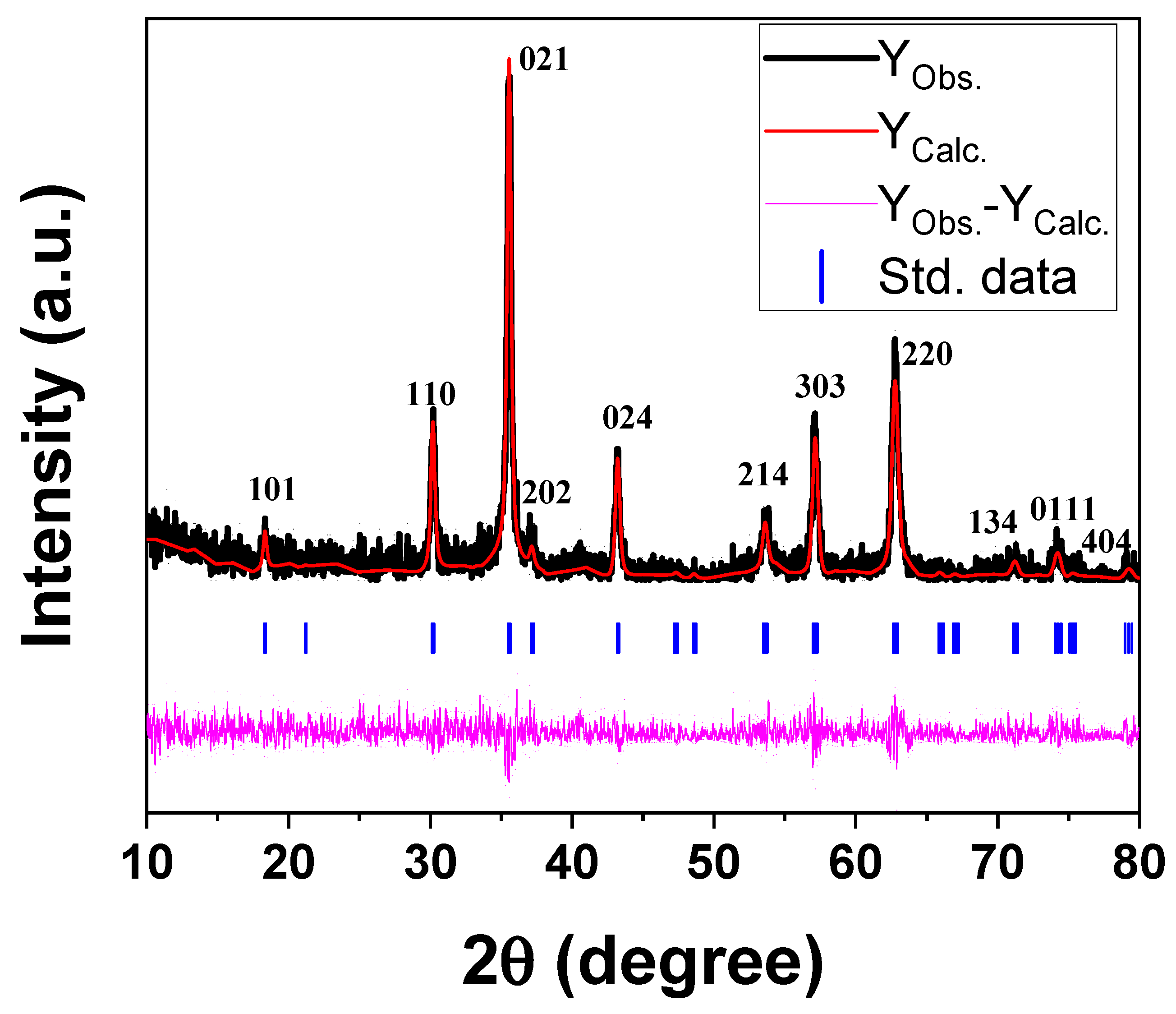

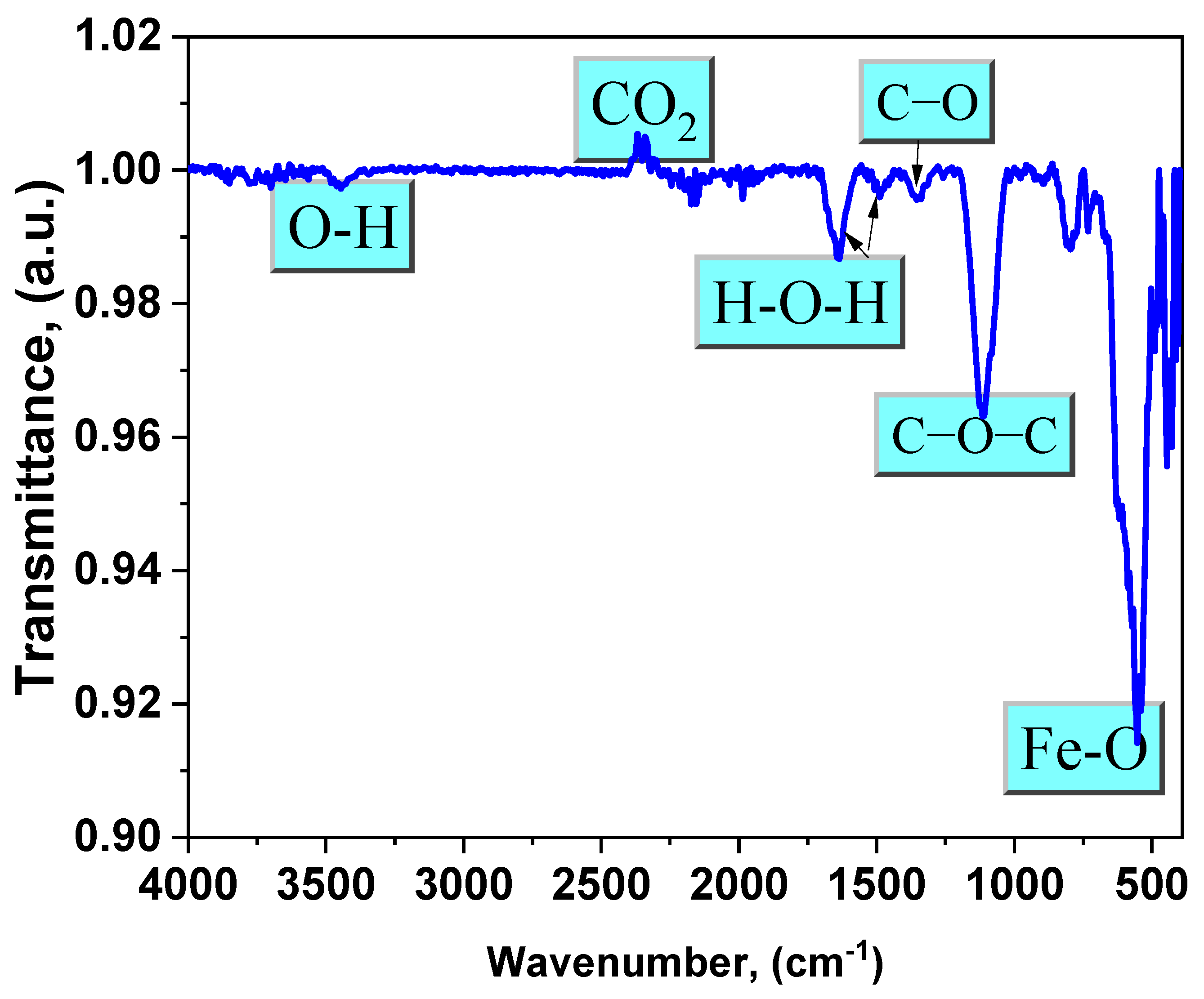





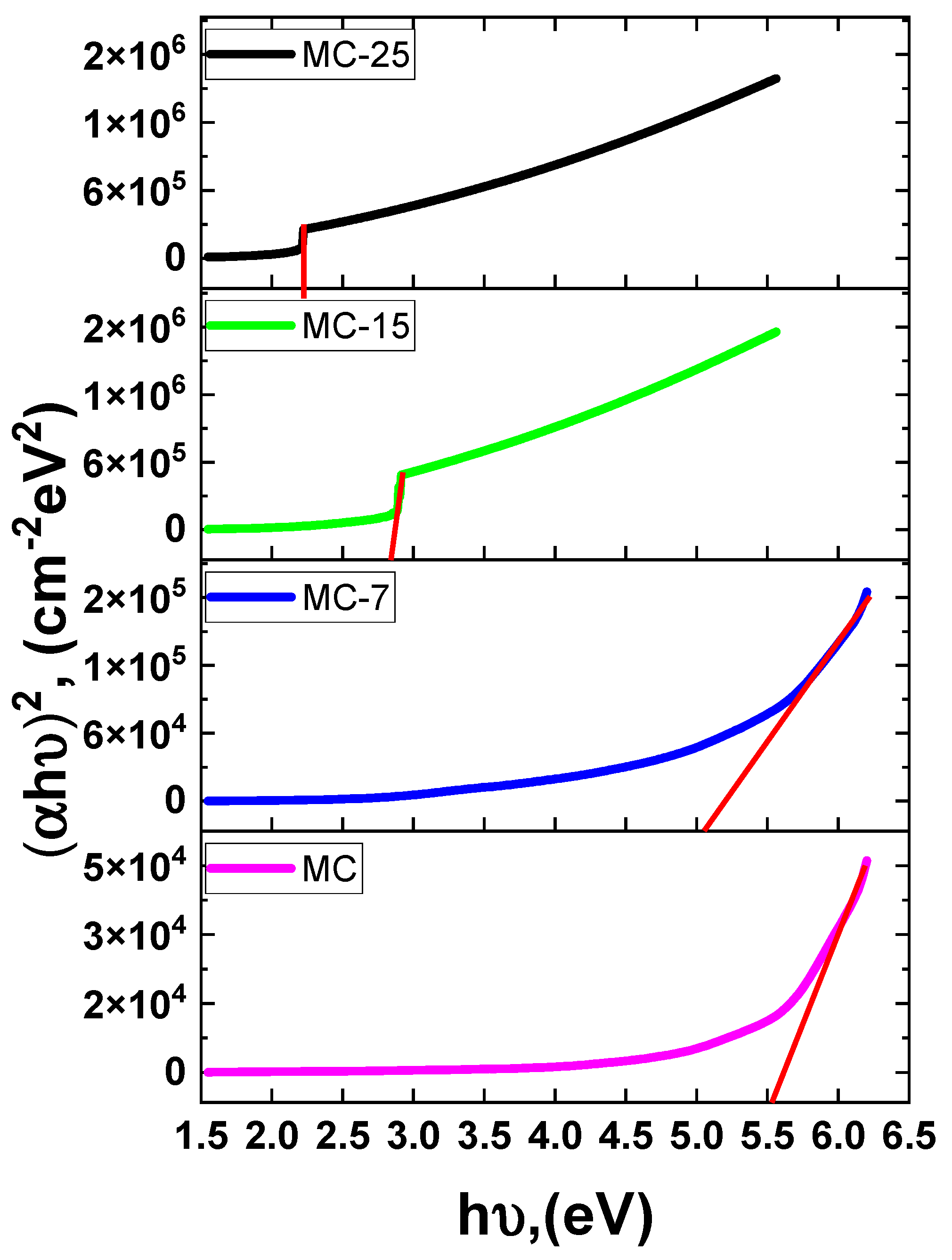
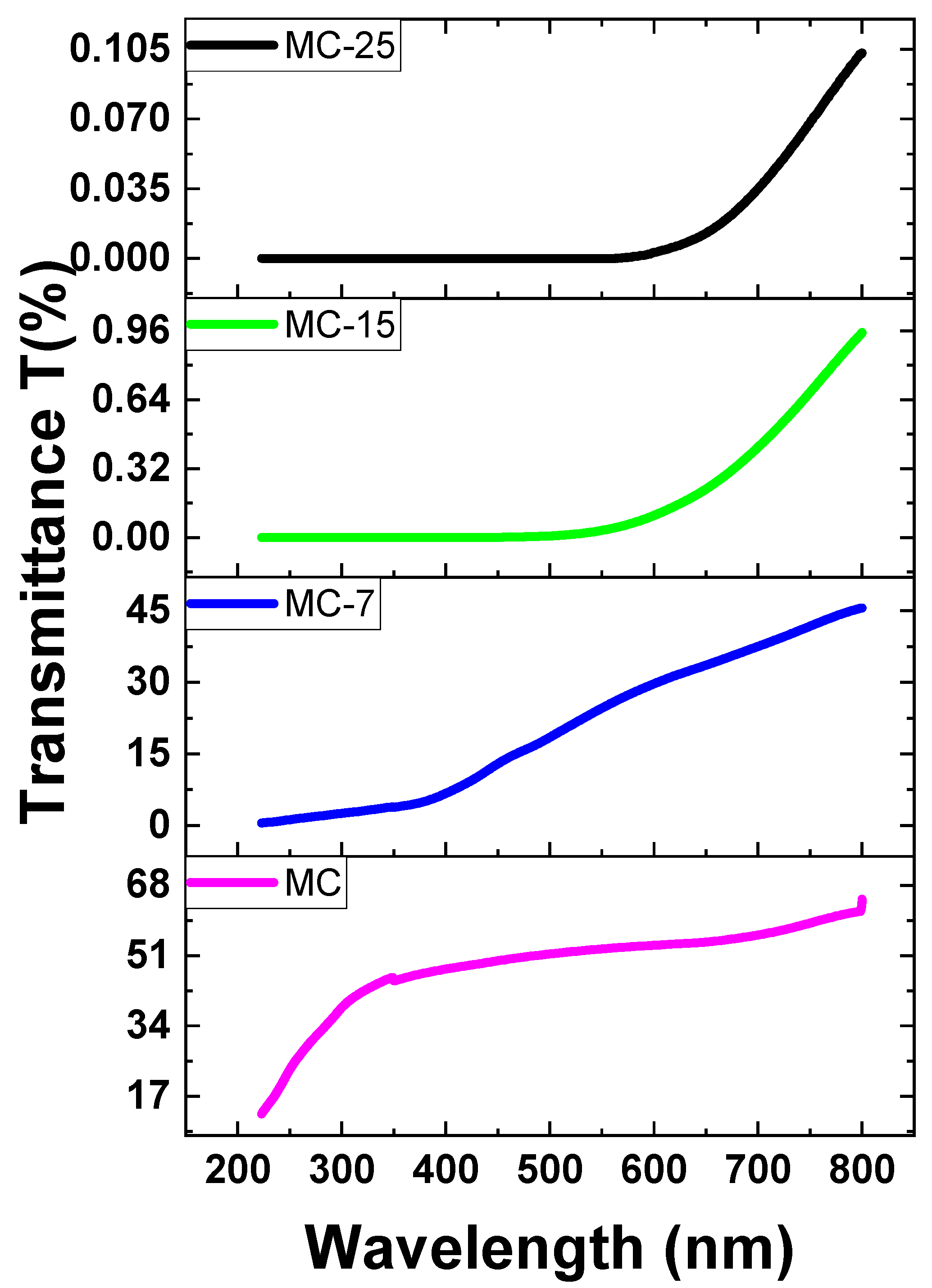
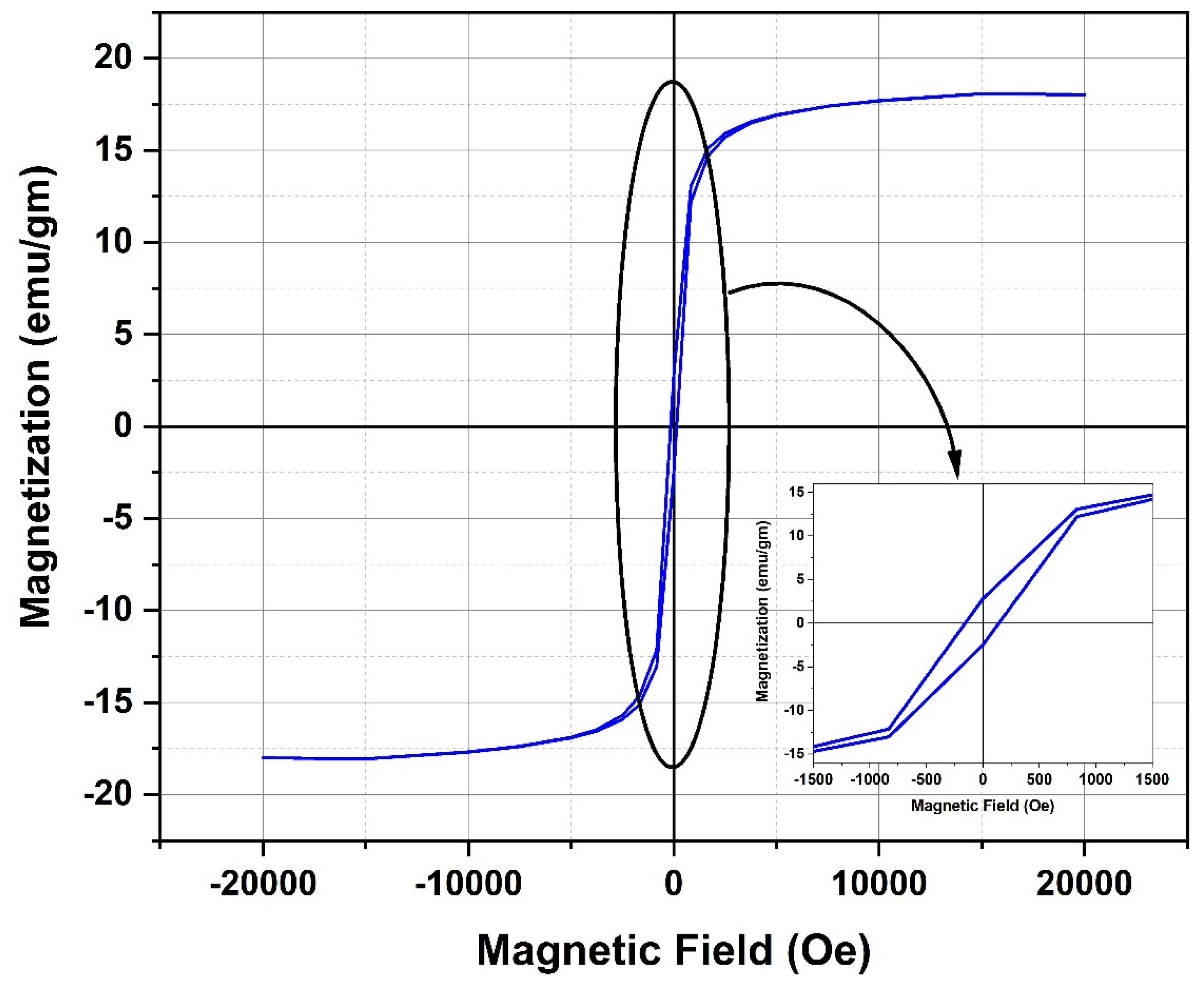
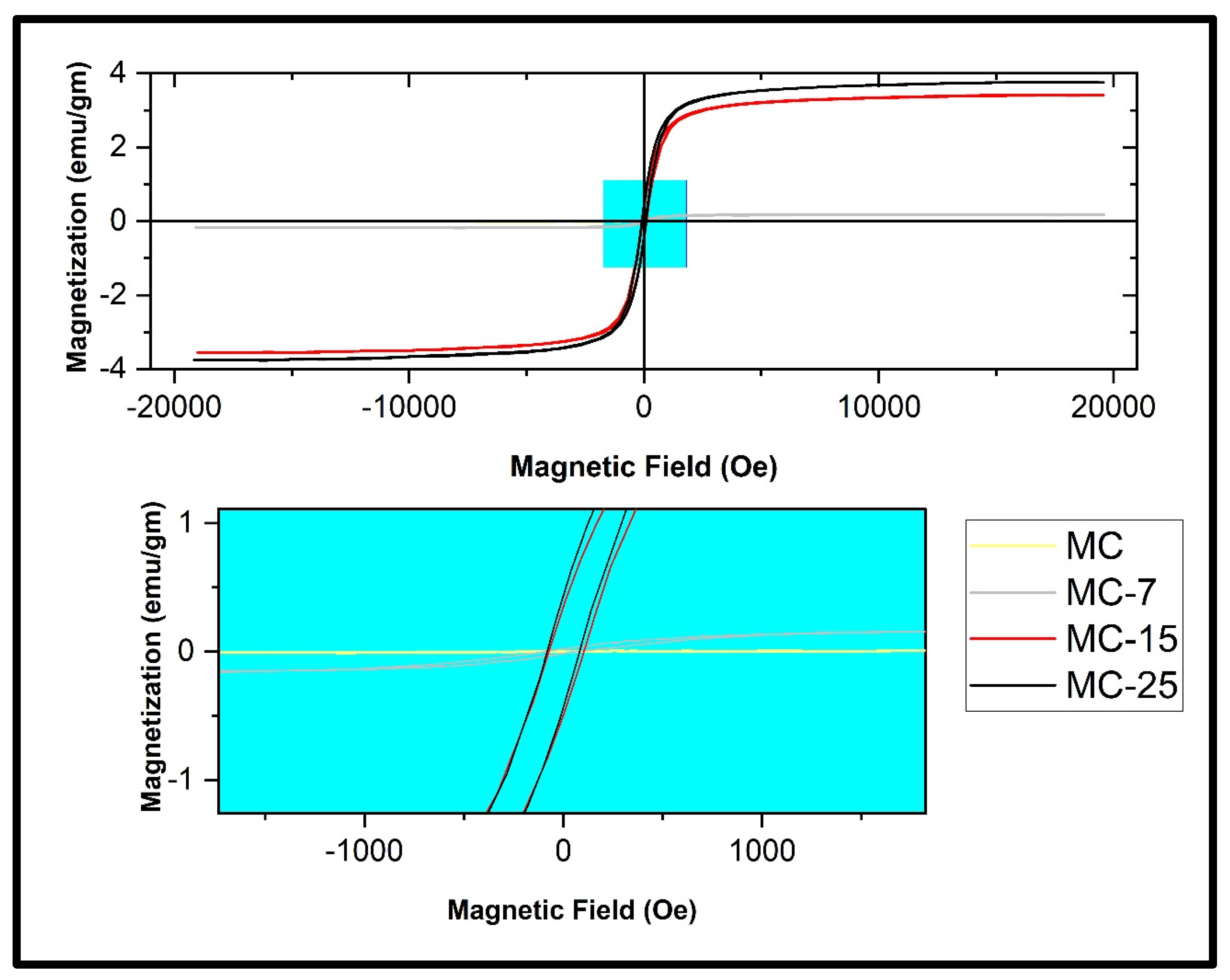
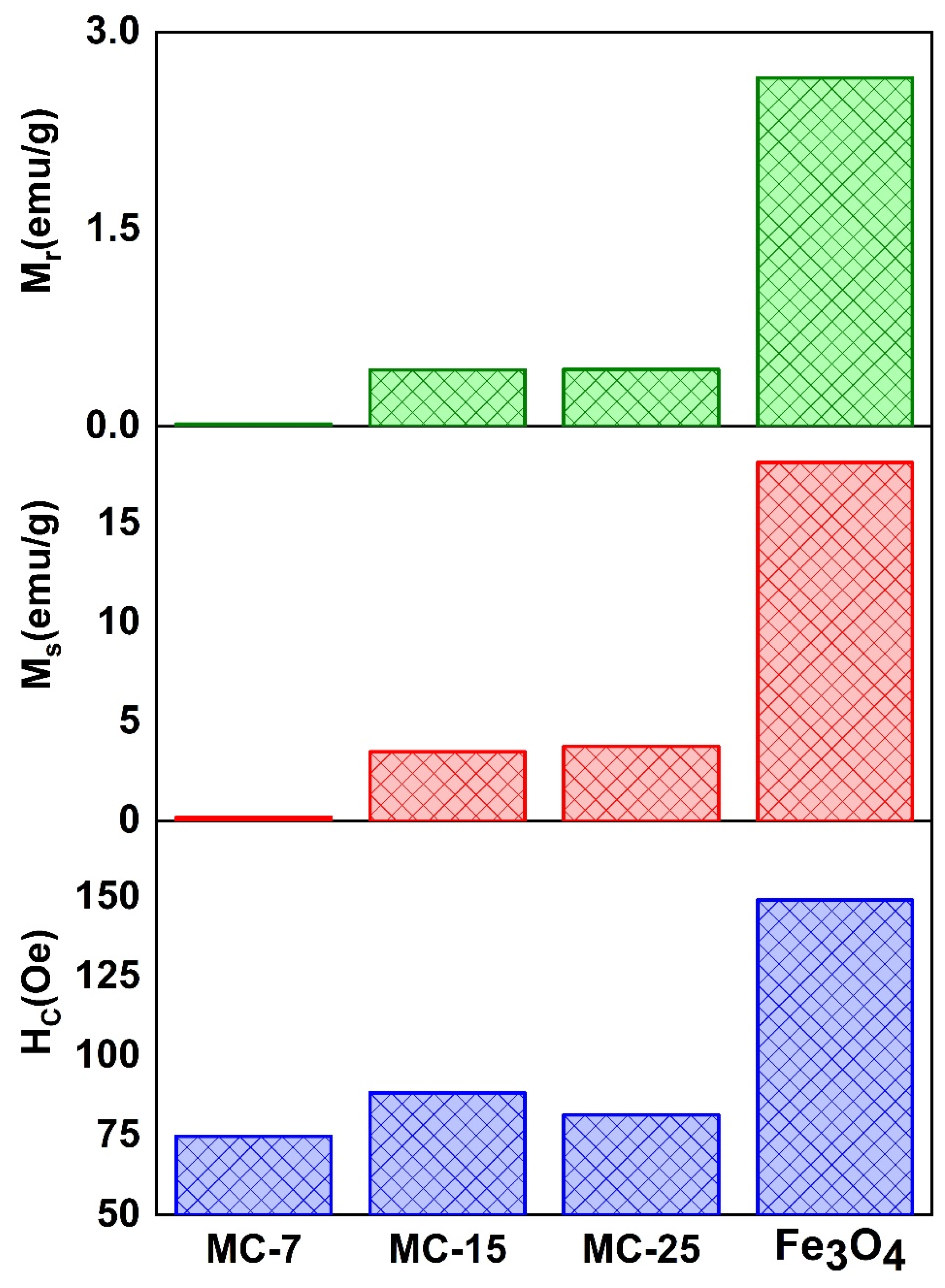
| Sample Name | Energy Gap (Eg), eV | Opacity, %/cm |
|---|---|---|
| MC | 5.51 | 2.7 |
| MC-7 | 5.05 | 5.2 |
| MC-15 | 2.84 | 29.8 |
| MC-25 | 2.20 | 45.3 |
Disclaimer/Publisher’s Note: The statements, opinions and data contained in all publications are solely those of the individual author(s) and contributor(s) and not of MDPI and/or the editor(s). MDPI and/or the editor(s) disclaim responsibility for any injury to people or property resulting from any ideas, methods, instructions or products referred to in the content. |
© 2024 by the authors. Licensee MDPI, Basel, Switzerland. This article is an open access article distributed under the terms and conditions of the Creative Commons Attribution (CC BY) license (https://creativecommons.org/licenses/by/4.0/).
Share and Cite
Farha, A.H.; Alshoaibi, A.; Saber, O.; Mansour, S.A. Novel Magnetite (Fe3O4)-Methylcellulose Nanocomposites Synthesized Using the Reverse Co-Precipitation Approach. J. Compos. Sci. 2024, 8, 282. https://doi.org/10.3390/jcs8070282
Farha AH, Alshoaibi A, Saber O, Mansour SA. Novel Magnetite (Fe3O4)-Methylcellulose Nanocomposites Synthesized Using the Reverse Co-Precipitation Approach. Journal of Composites Science. 2024; 8(7):282. https://doi.org/10.3390/jcs8070282
Chicago/Turabian StyleFarha, Ashraf H., Adil Alshoaibi, Osama Saber, and Shehab A. Mansour. 2024. "Novel Magnetite (Fe3O4)-Methylcellulose Nanocomposites Synthesized Using the Reverse Co-Precipitation Approach" Journal of Composites Science 8, no. 7: 282. https://doi.org/10.3390/jcs8070282







